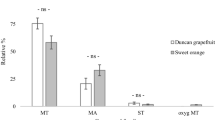Abstract
Volatile compositions of receptive (ready to be pollinated), postpollinated, and postparasitized figs, and leaves of Ficus hispida were analyzed. Differences among them were examined, and the specificity of fig wasp attractiveness was investigated. Linalool was the major constituent of steam-distilled oil of either male or female receptive figs, while dibutyl phthalate was the major compound of the oils of postparasitized and postpollinated figs. In petroleum ether extracts, palmitic oil, and 9,12-octadecadienoic acid were the main constituents of male and female receptive figs, while hexadecanoic acid ethyl ester was the major compound of postparasitized and postpollinated figs. In dichloromethane extracts, linalool was the major constituent of male and female receptive figs, 1-hydroxylinalool was the major component of male postparasitized figs, and 1-hydroxylinalool and benzyl alcohol were the major constituents of female postpollinated figs. Bioassays with sticky traps showed that Ceratosolen solmsimarchal was attracted to dichloromethane extracts of male and female receptive figs and to petroleum ether extracts of female receptive figs, but was not attracted to dichloromethane and petroleum ether extracts of male postparasitized and female postpollinated figs. Figs were attractive to pollinating wasps only at the receptive stage. The volatile constituents of receptive figs were different from those of postpollinated or postparasitized figs. From a receptive to a postpollinated state, figs changed in their volatile composition. Some compounds disappeared or decreased in amount. These include linalool, linalool oxide, α-terpeneol, and 2,6-dimethyl-1,7-octadiene-3,6-diol, which may act as the attractants of the wasps. Others increased in amount, or several additional chemicals appeared. These include dibutyl phthalate, 1-hydroxylinalool, and benzyl alcohol, which may be repellents of the wasps. That dichloromethane extracts of male and female receptive figs showed similar activities in attracting fig wasps indicates that receptive figs of both sexes are similarly attractive to fig wasps, which is further supported by their similar volatile composition. Leaf extract was not attractive to the wasps.
Similar content being viewed by others
REFERENCES
BAIJNATH, H., NAICKER, S., and RAMCHARUN, S. 1986. The interaction of figs and fig wasps, pp. 348-349, in B. E. S. Juniper and T. R. E. Southwood (eds.). Insect and the Plant Surface. Edward Arnold, London.
BARKER, N. P. 1985. Evidence of a volatile attractant in Ficus ingens (Moraceae). Bothalia 15:607-611.
BRONSTEIN, J. L. 1987. Maintenance of species specificity in a neotropical fig-pollinator wasp mutualism. Oikos 48:39-46.
BRONSTEIN, J. L. 1992. Seed predators as mutualists: ecology and evolution of the fig/pollinator interaction, pp. 1-44, in E. Bernays (ed.). Insect-Plant Interactions, Vol. IV. CRC Press, Boca Raton, Florida.
BUTTERY, R. G., FLATH, R. A., MON, T. R., and LING, L. C. 1986. Identification of germacrene D in walnut and fig leaf volatiles. J. Agric. Food Chem. 34:820-822.
CARDé, R. T. 1984. Chemo-orientation in flying insects, pp. 111-124, in W. J. Bell and R. T. Cardé (eds.). Chemical Ecology of Insects. Chapman and Hall, London.
CONDIT, I. J. 1947. The Fig Chronica Botanica. Waltham.
GALIL, J. 1977. Fig biology. Endeavour 1:52-56.
GIBERNAU, M., BUSER, H. R, FREY, J. E., and HOSSAERT-MCKEY, M. 1997. Volatile compounds from extracts of figs of Ficus carica. Phytochemistry 46:241-244.
GRISON, L., EDWARDS, A. A., and HOSSAERT-MCKEY, M. 1999. Interspecies variation in floral fragrances emitted by tropical Ficus species. Phytochemistry 52:1293-1299.
HILLS, H. G., WILLIAMS, N, H., and DOBSON, C. H. 1972. Floral fragrances as isolating mechanisms in the genus Catasetum (Orchidaceae). Biotropica 4:61-76.
JANZEN, D. H. 1979. How to be a fig. Annu. Rev. Ecol. Syst. 10:13-51.
MILLER, J. R. and STRICKLER, K. L. 1984. Finding and accepting host plants, pp. 127-155, in W. J. Bell and R. T. Cardé (eds.). Chemical Ecology of Insects. Chapman and Hall, London.
OWENS, E. D. and PROKOPY, R. J. 1986. Relationship between reflectance spectra of host plant surfaces and visual detection of host fruit by Rhagoletis pomonella. Physiol. Entomol. 11:297-307.
RAUSHER, M. D. 1978. Search image for leaf shape in a butterfly. Science 200:1071-1073.
RAMIREZ, B. W. 1970. Host specificity of fig wasps (Agaonidae). Evolution 24:680-691
RAMIREZ, B. W. 1974. Coevolution of Ficus and Agaonidae. Ann. Mo. Bot. Gard. 61:770-780.
VAN NOORT, S., WARE, A. B., and COMPTON, S.G. 1989. Pollinator specific volatile attractants released from the figs of Ficus burtt-davyi. S. Afr. J. Sci. 85:323-324.
WARE, A. B. and COMPTON, S. G. 1994. Responses of fig wasps to host plant volatile cues. J. Chem.Ecol. 20:785-802.
WARE, A. B., COMPTON, S. G., KAYE, P. T., and VAN NOORT, S. 1993. Fig volatiles: Their role in attracting pollinators and maintaining pollinator specificity. Plant Syst. Evol. 186:147-156.
WIEBES, J. T. 1979. Co-evolution of figs and their insect pollinators. Annu. Rev. Evol. Syst. 10:1-12.
XU, Z. 1994. Ficus trees: Keystone species of tropical rain forest ecosystem in southern Yunnan, China. Chin. Biodivers. 2:21-23 (in Chinese with English abstract).
YANG, D., LI, C., and YANG, B. 1997. Studies on the diversity and structure of animal community living on the Ficus trees in Xishuangbanna tropical rain forest. Zool. Res. 18:189-196 (in Chinese with English abstract).
YANG, D., LI, C., HAN, D., and YAO, R. 1999. The impact of the fragmentation of tropical rain forest on fig wasps and Ficus species. Zool. Res. 20:126-130 (in Chinese with English abstract).
Author information
Authors and Affiliations
Rights and permissions
About this article
Cite this article
Song, Q., Yang, D., Zhang, G. et al. Volatiles from Ficus hispida and Their Attractiveness to Fig Wasps. J Chem Ecol 27, 1929–1942 (2001). https://doi.org/10.1023/A:1012226400586
Issue Date:
DOI: https://doi.org/10.1023/A:1012226400586




